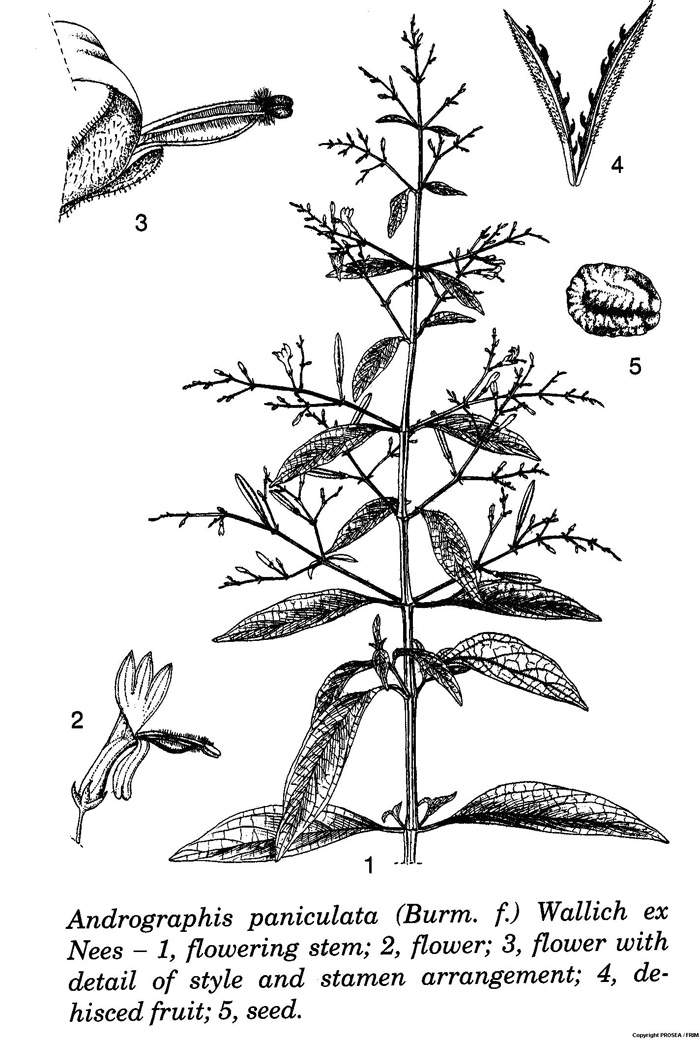Andrographis paniculata
Family
Acanthaceae
Synonyms
Andrographis subspathulata C.B. Clarke.
Vernacular Names
| Malaysia | Hempedu bumi, akar cerita, empedu tanah. |
| English | Creat, green chireta. |
| Indonesia | Ki oray (Sundanese), sambilata (Javanese), ampadu (Padang). |
| Philippines | Aluy, lekha (Tagalog), sinta (Bikol). |
| Thailand | Fa thalaai(Bangkok), khee-pang-hee(Chinese), yaa kannguu (Songkhla). |
| Vietnam | C[oo]ng c[ooj]ng, kh[oor] di[eej]p, xuy[ee]n t[aa]m li[ee]n. |
| French | Roi des amers. |
Geographical Distributions
A. paniculata is probably native to India, but has been introduced and cultivated as a medicinal plant in many parts of Asia including Indo-China, China, Thailand, Peninsular Malaysia, Indonesia, the Philippines and Australia. It is now widely naturalized in most of these regions. It has also been introduced, possibly for its ornamental value, in the West Indies and Central America.
Description
It is a perennial herb that can grow from 30-100 cm tall. The stem is distinctly 4-angular and smooth apart from a few hairs at the nodes. The leaves are opposite, simple and narrowly egg-shaped to lance-shaped that size 5-10 cm x 1.2-2.5 cm. The apex is acuminate while the margin is entire and hairless but often gland-dotted. The petiole is short, up to 6 mm long and it is connected to the opposite one by transverse ridges. Flowers are in lax, axillary and terminal racemes or panicles combined into a pyramidal inflorescence, with 2 small bracteoles at base of the 1-7 mm long pedicel. The flowers are bisexual and zygomorphic. The sepal has 5 segments, joined at the base, with glandular and aglandular hairs. The petal is bilabiate, white or rose with purple markings on the upper lip. The petal tube is between 5-6 mm long, slightly enlarged below the limb. The lower lip is 4-6 mm long, oblong and it is 2-toothed at the apex while the upper lip is deeply 3-lobed, also 4-6 mm in length. It has 2 stamens that are inserted at the petal tube apex and exserted. The filaments are hairy with the anthers are inserted at the equal level. At the base they are united and bearded, deep purple to black in colour. The ovary is superior. It is 2-locular with 3-7 ovules in each cell, the style is curved upwards and the stigma is entire. The fruit is erect, narrowly ellipsoidal and has glandular hairy capsule with the size of 14-20 mm x 3-3.5 mm. This is a species that is many-seeded Seeds are held up on well-developed hooks (retinaculae), almost rectangular and with 2 deep furrows. (1)
Ecology / Cultivation
A. paniculata is locally common and often gregarious. It exhibits weedy characteristics and occurs from sea-level up to 1600 m altitude in village groves, roadsides, waste places, open sandy locations and fields, but also in monsoon and teak forest receiving only 10-20% of full light.
Line Drawing / Photograph
Read More
1) Cultivation.
3) Western Herb
4) Ayuverda
References
-
View Abstract: Plant Resources of South-East Asia No 12(2). 1998, Unesco.



